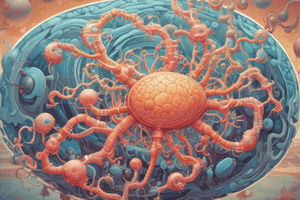Podcast
Questions and Answers
What are the three stages of transcription?
What are the three stages of transcription?
Initiation, Elongation, Termination
What is the direction of transcription in prokaryotes?
What is the direction of transcription in prokaryotes?
IT’S THAT WAY
What is required to recruit and position RNA polymerase in bacterial promoters?
What is required to recruit and position RNA polymerase in bacterial promoters?
- Transcription factors
- Sigma factor (correct)
- Ribosomes
- Histones
Transcriptional regulation in prokaryotes and eukaryotes occurs mostly at the level of ____________.
Transcriptional regulation in prokaryotes and eukaryotes occurs mostly at the level of ____________.
Transcriptional regulation in prokaryotes can involve pausing, elongation, and termination.
Transcriptional regulation in prokaryotes can involve pausing, elongation, and termination.
What is the purpose of the Lac Operon in E. coli?
What is the purpose of the Lac Operon in E. coli?
Binding of the lac repressor and CAP in Lac Operon is reversible.
Binding of the lac repressor and CAP in Lac Operon is reversible.
What occurs even when the Lac Operon is repressed?
What occurs even when the Lac Operon is repressed?
What is the consequence for an E. coli cell lacking a CAP site adjacent to the lac promoter?
What is the consequence for an E. coli cell lacking a CAP site adjacent to the lac promoter?
Study Notes
Visualising Transcription
- Two genes being transcribed (rRNA genes) can be visualised by electron microscopy
- Multiple transcripts from each gene are transcribed concurrently
- Direction of transcription can be determined
Transcription in Prokaryotes
- Three stages of transcription: Initiation, Elongation, and Termination
- E. coli Promoters:
- Required to recruit and position RNA polymerase
- Usually don't know where to start
- Sigma factor required for sequence-specific DNA binding
- Sigma factor binds RNA polymerase and dissociates after initiation
- Bacterial Transcription Cycle:
- RNA polymerase unwinds DNA and starts copying the template strand
- Sigma factor releases
Transcription Elongation (Bubble)
- RNA polymerase bonds nucleotides base-paired to template DNA
- Elongation phase of transcription
Termination of Transcription in E. coli
- Two mechanisms of termination:
- "Rho Independent":
- GC-rich sequence precedes termination
- G-C base pair forms a stable stem-loop structure
- Followed by U-rich sequence (weak RNA-DNA bonding)
- mRNA detaches
- "Rho Dependent":
- Rho attaches to newly transcribed RNA during transcription
- Rho is a helicase that unwinds DNA-RNA complex to release RNA
- "Rho Independent":
Control of Transcription
- Gene expression is regulated mostly at the level of transcription
- Most transcriptional regulation occurs at the level of initiation
- Many copies of mRNA are transcribed with short half-lives
- Advantage of having many copies of short-lived RNA molecules: allows for rapid response to changing environment
Lac Operon
- Classic example of transcriptional control in E. coli
- Purpose: to hydrolyse lactose so glucose can be used for energy
- Multiple genes regulated together:
- β-galactosidase
- Permease
- Lac Operon - Overview:
- Lac repressor is active in its native state (binds DNA and represses transcription)
- Allosteric binding of allolactose prevents DNA binding
- CAP protein is inactive in its native state (cannot bind DNA) and requires allosteric binding of cAMP for DNA binding
- Lac Operon by condition:
- No lactose, no glucose: operon repressed
- With lactose, no glucose: operon activated
- No lactose, with glucose: operon repressed
- With lactose, with glucose: operon weakly active
Lac Operon - Key Concepts
- Binding of CAP and the lac repressor is sequence-specific, non-covalent, and reversible
- Even when the operon is repressed, a little bit of transcription still occurs
- Activators recruiting RNA polymerase/sigma factor is a common control mechanism in bacteria (e.g. CAP in the lac operon)
- Cooperative binding is a key concept in biochemistry (e.g. binding affinity of 2 > sum of each individual)
Studying That Suits You
Use AI to generate personalized quizzes and flashcards to suit your learning preferences.
Related Documents
Description
This quiz covers the concept of transcription in prokaryotes, including visualisation of transcription and direction of transcription. It is based on Lecture 8 by Dr. Adrian Hunter.




![Transcription in Prokaryotes: RNA Polymerase [Part 1]](https://assets.quizgecko.com/cdn-cgi/image/width=300,height=200,fit=crop,quality=75,format=webp/quiz/baed4520f1a7fc99e7641e1e05a42c62.jpg)